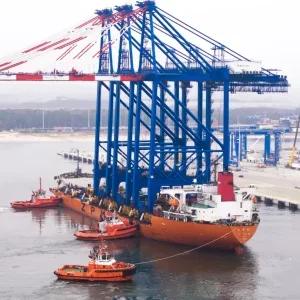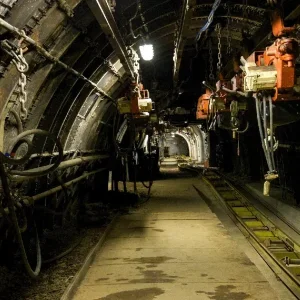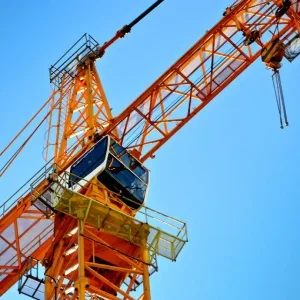Slovenia is in many ways typical of eastern European countries in that it has an active domestic crane manufacturing industry, largely based on imported components.
There are six signficant overhead crane manufacturers, says Vinko Praprotnik, managing director of Metalna SRM, and five of them are representatives of German or Italian producers, namely Demag, SWF, Stahl, Abus and Misia.
Praprotnik says that Metalna, however, mostly specialises in custom-made cranes for heavy duty applications. “Our cranes are made for working with magnets, tongs, vacuum lifting devices, weighting devices and are fully frequency regulated,” he says. “We buy the components such as motors, brakes, couplings, gearboxes and electrical equipment, but we make trolleys, reels, sheaves and wheels ourselves, as well as steel structures.”
It is hard to estimate the size of the market, he says, since there is officially collected data, but business appears good. “The market in Slovenia is growing, and more and more companies are modernising old cranes and buying new cranes,” he says. “Our sales have grown very fast in the years from 2003 to 2005.”
Metalna’s turnover in 2003 was Euros 4.4m; in 2004 it was Euros 6.0m; and 2004 it reached Euros 8.0m. “The figure in 2005 is a result of one exceptional year which cannot repeat itself so easily,” Praprotnik says, and so 2006 sales are forecast to be approximately Euros 7m.
Approximately 30% of production is exported, mostly to neighbouring Austria, Croatia, Bosnia and Herzegovina, he says.
Andrej Oblak of the Misia representative Insem-Atmos confirms that the market is generally growing. Demand in 2005 was up 75 to 100% on just a few years ago for cranes with a capacity greater than 5t, he says.
“Our production has increased from 80 cranes in 2004 to 100 in 2005,” Oblak says. This includes jib cranes and small 125kg monorail cranes as well as double girder cranes up to 30t capacity. “According to orders we have received so far this year 2006 can be only better than 2005. So I suspect that this would be a general trend in Slovenia, not just for us.”
The domestic market accounts for 90-95% of production, Oblak says, with the rest going to Croatia.
As well as Misia wire rope hoists, Insem-Atmos uses U-Mega chain hoists, Watt gear reducers, ByCarpel festooning and Autec radio remote controls. “We produce end carriages (complete with wheels and everything that is included), main girders (box girder or from HEA, HEB profiles), and below the hook attachments,” Oblak says.
He adds: “If the customer requires something that our hoist supplier doesn’t have in its range, then we either modify the standard hoist to suit the customer needs or make it ourselves. Sometimes we make a double rail trolley if we cannot use the standard one supplied by Misia.”
Slovenia was one of the 10 countries that joined the European Union in May 2004. According to the European Commission, their membership has brought the new member states economic and social benefits.
Oblak and Praprotnik agree, up to a point. Oblak says: “The crane business hasn’t changed much in Slovenia since we joined the EU because we were already well connected to the EU before. It just made it easier for the companies who bought a crane (or any other product) from a manufacturer who doesn’t have a representative in Slovenia, as there are now no borders and no customs. Joining the EU also made it easier for us because we were importing some of the components for cranes and we now don’t have any charges or time lost at customs at the border.”
Praprotnik says that Slovenia has become more open to “new technology, new business connections and new ideas”. He says business has been made easier and more efficient by the abolition of customs’ administration. “But when you ask the business people how they feel this situation they usually say: It is much easier to buy now, but at the same time it is also much more difficult to se…”
Poland is another new member of the EU. Marcin Fiedur of Polish crane manufacturer Systemy Transportu Bliskiego Panda comments: “Since we joined the EU we have observed that the need for our products is constantly growing due to overall economic growth in Poland. It may be caused by EU funds supporting Polish heavy industry. We also observe an increase in the number of foreign investors in our country.”
STB Panda, established in 1988, describes itself as “one of the leading companies in crane production in Poland”. It represents SWF Krantechnik of Germany. As well as producing EOT and jib cranes and below the hook equipment, it also has a modernisation, service and maintenance business.
In 2005 STB Panda’s sales rose 20% on 2004, Fiedur says, and a further 17% increase is forecast for 2006. “The current condition of our business is good and is reflected by the fact that we have just started building a new extension to our workshop,” he says.
Almost 100 years older than Panda is Fabryka Urzadzen Dzwigowych SA (FUD) was founded in 1896. With an installed base of more than over 11,000 overhead travelling cranes, jib cranes, dock cranes and container handling cranes, FUD equipment can be found at work in the majority of Poland’s medium to large industrial premises.
Economic liberalisation of the 1990s exposed FUD to market conditions. In 1995 it became a joint stock company and was subsequently privatised, with the shares distributed among 15 national investment funds, the state and the workforce. More recently it was acquired by the Kingfisher Group.
FUD says that it has since strengthened its position in traditional markets as well as entered new ones. “New products have been introduced and output productivity has been substantially increased. The company’s technical know-how has been considerably enhanced under the direction of new management and a group of talented young design engineers,” it says.
Bulgaria and Romania are scheduled to join the European Union in January 2007, although there are still a few hurdles they have to jump first. The Commission has said that Bulgaria must show tangible results in its fight against corruption and organised crime, while Romania has more administrative issues to tackle, relating to food safety and payment of farm subsidies. A final decision is expected in October.
For a country with a population of just a little over seven million, Bulgaria has a remarkably active crane and hoist producing industry.
As reported in the November 2004 issue of Hoist, one of the largest hoist producers in the country is Podemcrane, the successor company to Podem AD, based in the town of Gobrovo.
With more than 1.8 million lifting equipment units sold worldwide in its history, it is hard to dispute its claim to be the largest in central and eastern Europe.
Most of the company’s current annual production of approximately 4,000 electric wire rope hoists is exported through a network of distributors in the USA (where its partner is Acco), Canada, Spain, Italy, Greece, Russia, Poland, Ukraine, Iran, Syria and Vietnam.
Bulgaria’s other major exporter is Balkancarpodem (BCP), based in the capital, Sofia. BCP produces electric wire rope hoists with rated capacities from 250 kg up to 16 tonnes. More than 2.3 million of its “T” series hoists have been sold in more than 60 countries of the world.
Recently, this series has been updated. The new MH series is designed to meet FEM and ISO standards and displays a modular approach to design, with a two-stage heliocentric gear unit mounted to one side of the body.
“We still also produce the old type “T” hoists with the round body [MH hoists have a rectangular body] for clients that request them, mostly for the Middle East,” says sales manager Stoyan Milev.
BCP is also a crane builder as well as a hoist manufacturer and all its products are TÜV and CE certified. “For Canada and USA we have inspections from IMQ Italy twice a year to get the CSA mark,” Milev adds.
Milev says that BCP has been in the crane and hoist business for more than 40 years and the founder, Mr Buzov, is still president of the company.
Neither Podemcrane nor BCP face the kind of demand that they saw in the 1980s. In those days, to meet the industrialisation needs of the Soviet bloc, BCP was producing 105,000 wire rope hoists a year and 35,000 chain hoists a year, Milev says. At the same time, Podem was producing 90,000 electric wire rope hoists a year.
These days BCP is making about 5,000 wire rope hoists a year and 800 electric chain hoists.
Like Podem, BCP exports approximately 90% of its production. Both customers have prospered in recent years from export demand.
BCP has subsidiaries and partners in more than 40 countries, Milev says. Distributors include Austin Hoist & Crane in Victoria, Australia and Mizia Hoists Inc in Ontario, Canada. It also supplies Vincsan of Turkeu, Milev says, and it has 100%-owned subsidiaries in Germany (Deutsche Balkancarpodem GmbH in Berlin), Poland and Hungary.
“Depending of the request of the client, we produce the hoist with or without electric equipment. We are prepared to make special executions for our clients,” Milev says. For example, a low headroom trolley has been made for a replacement application in Australia where there was just 450mm of headroom. For the Netherlands, BCP ships hoists without electric equipment or rope and with single speed for trolley and lifting motions because frequency control drives are added locally. For the USA, a second brake (supplied by Lenze) is added to every hoist.
Increasingly, Milev, says, the business is focused on supply components and crane kits rather than complete built-up systems. “We see that clients now are looking only for components and not complete cranes,” he says. “We have the capability to produce all types of cranes, but 80% is double rail crane crabs, block travel wheels, motor reducers and end carriages.”
Milev says that BCP also supplies hoist components to numerous hoist companies around the world who assemble them in their own country, put their own branding on them and sell them as original equipment.
BCP produces other material handling equipment as well as cranes and hoists. Only one of its four factories is dedicated to cranes and components. Other products include chain and lever blocks and hand pallet trucks.
It also produces forklift trucks, which it is now supplying to the Iraqi Ministry of Oil. Other prominent hoist producers in Bulgaria include Aytos Cranes, Kramex and Skladova Technica. Aytos Cranes produces “730 modifications of hanging, bridge, gantry, wall and column cranes with capacity from 500kg to 50 tonnes”, the company says. It also produces its own hoists for these cranes. It has supplied cranes to more then 50 countries worldwide, it says, and clients have included nuclear power plants in Bulgaria, the Aeroflot airline in Russia, Mitsubishi in Japan and the Indian army.
Kramex, based in Sofia, is another long-established crane builder offering single girder overhead cranes with electric hoists up to 12.5t rated capacity and double girder cranes up to 250t. Lift speeds range from 1m/min to 12m/min, cross-travel up to 32m/min and long travel up to 63m/min.
Skladova Technica, in contrast, is a commodity supplier of electric chain hoists with rated capacities from 125kg up to 4000kg, hoisting heights up to 10m and hoisting speeds up to 10/2.5 m/min.
Other product lines include fireplaces and stoves, electric cookers and fire extinguishers. It is a privately owned joint stock company that dates back to 1916, when it was established as a smithy.
A centre for crane engineering and expertise In Bulgaria is the former Crane-building Institute, now privatised and called Kranostroene Engineering Ltd. It acts as a specialist engineering consultancy in crane design with limited production resources.
“We are a small company and with about 35 staff,” says managing director Ivan Todorovski. “Our basic activity is design of cranes on the basis of customer needs. We manufacture on our own small single-girder bridge cranes and tower-cantilever cranes, as well as separate crane components. We arrange manufacturing of cranes to our design in partnership with other companies,” he explains.
It also installs electrical components and control systems and offers supervision services for the assembly and installation of cranes that it has designed. Kranostroene also has a testing laboratory for cranes and construction machinery.
Todorovski says that Kranostroene has grown strongly in the past five years. Sales turnover has risen nearly sixfold since 2005 and annual net profits have grown by a factor of 75.
This growth – particularly in profitability – is mainly due to orders from abroad, particularly Russia, Ukraine and Kazakhstan, Todorovski says. In 2000, just 5% of sales were exports. By 2003 exports accounted for 67% of sales and in 2004 it was 71%. Last year a significant part of sales came from service, repair, refurbishment and modernisation contracts on Bulgaria’s huge installed base of aging overhead cranes, and the export ratio fell back to 35%.
In Romania, too, there appears to be growth in the crane industry, at least if the results of Elmas Brasov are any indication.
Elmas has seen its turnover rise dramatically from approximately Euros 1m in 1999, to Euros 3m in 2001, Euros 8.5m in 2004 and Euros 10m in 2005. Employee numbers have risen from 50 to 200 over the same period.
The company was established in 1991 and in 1993 became the Romanian representative for Demag Cranes & Components. In 2005 it began production of EOT cranes under licence from Demag.
Not all revenue comes from cranes, however, since the company also sells elevators and escalators and is a distributor of Linde forklift trucks.






